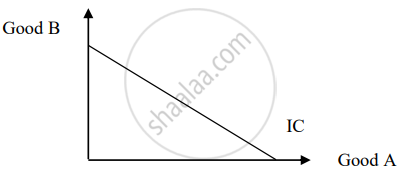Advertisements
Advertisements
प्रश्न
If Marginal Rate of Substitution is increasing throughout, the Indifference Curve will be: (Choose the correct alternative)
a. Downward sloping convex
b. Downward sloping concave
c. Downward sloping straight line
d. Upward sloping convex
उत्तर
Downward sloping concave
Assume that the marginal rate of substitution is increasing throughout; the indifference curve would be a downward sloping concave because the consumer can get higher marginal utility from each additional unit of output.
APPEARS IN
संबंधित प्रश्न
Explain the conditions of consumer’s equilibrium using indifference curve analysis.
Explain the three properties of the indifference curves.
Define an indifference curve.
Explain why an indifference curve is downward sloping from left to right.
State the meaning and properties of production possibilities frontier.
Why is an indifference curve negatively sloped? Explain.
Define indifference map.
A consumer consumes only two goods. If the price of one of the goods falls, the indifference curve: (Choose the correct alternative)
a. Shifts upwards
b. Shifts downwards
c. Can shift both upwards or downwards
d. Does not shift
Define an indifference map. Why does indifference curve to the right show more utility? Explain.
Identify the correct pair of items from the following Columns I and II:
| Columns I | Columns II |
| (1) Demand Curve | (a) Downward sloping |
| (2) Indifference curve | (b) Upward rising |
| (3) Marginal Utility Curve | (c) L shaped curve |
| (4) Total Utility Curve | (d) Y shaped curve |
Assertion (A): A lower indifference curve represents a higher level of satisfaction.
Reason (R): According to the Indifference Curve Approach, utility is an ordinal concept, that is, it can be ranked and not measured.
"Higher indifference curve represents fewer quantities of one or both goods, a higher indifference curve shows higher utility level." Choose the correct option for the above mentioned statement:
Identify the correct pair of items from the following Columns I and II:
| Column I | Column II |
| (1) Monotonic Preferences | (a) Consumer preferences are called monotonic when between any three bundles, consumers always choose a bundle having more of one good and no less of other goods. |
| (2) Indifference Set | (b) It is a set of those divisions of two goods that offer the consumer the same level of satisfaction so that the consumer is indifferent across any number of combinations in his indifference set. |
| (3) Indifference Curve | (c) It is a curve showing the different combinations of two goods, each combination offering the same level of satisfaction to the consumer. |
| (4) Indifference Map | (d) It refers to a set of indifference curves placed in different diagrams for the same type of goods. |
Which of the following statements are incorrect?

Points K and T will NOT be attained by the consumer. Select the reason from the options given below.
Will you defend or refute the case depicted in the following diagram? Provide a rationale in support of your view.

